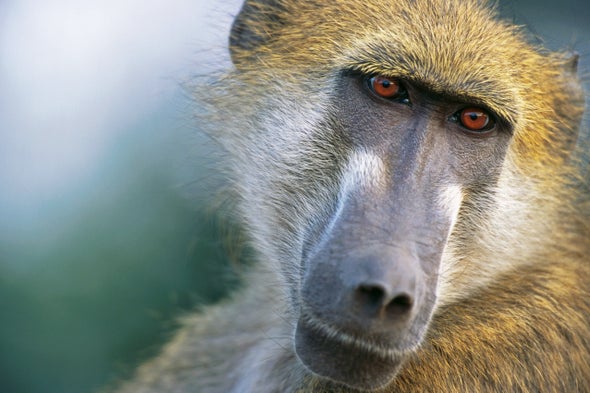
Posted on 12/06/2018 12:37:41 PM PST by Red Badger

Baboons can stand in for humans during cross-species transplantation studies. Now, for the first time, researchers have kept baboons alive and healthy for up to six months on transplanted pig hearts. Credit: Paul A. Sounders
=========================================================================
In four adjacent enclosures transplantation researcher Bruno Reichart kept four happy baboons. “They can hop around, eat, drink and they are enjoying life,” he says. “They watch TV—their favorite is the cartoon with the chipmunk.” Most importantly, he says, they were healthy and normal—which is astonishing, given the fact that the hearts beating life in their chests were anything but normal for a baboon.
All four of the baboons that lived in Reichart’s lab at Ludwig Maximilian University of Munich had their original hearts surgically replaced with ones from genetically engineered pigs. Two of the baboons were euthanized after they lived 90 days—the survival period for any nonhuman primate set by the International Society for Heart and Lung Transplantation as a benchmark to indicate xenotransplantation might be safe enough to try in humans. The other two kept going for twice as long before Reichart’s team euthanized them, too. That survival period, says Muhammad Mohiuddin, a surgeon and director of the Cardiac Xenotransplantation Program at the University of Maryland who was not involved with this work, “is an extraordinary achievement. You cannot stress this more. The next step from here is clinical transplantation [in people].”
Despite the fact monkeys are our evolutionary cousins and can stand in for us fairly well in experiments, nonhuman primates make for poor organ donors. There are concerns a monkey organ could pass on infectious diseases to the human recipient, and the primates are not easily farmed. But there is one animal that is already bred and raised en masse, is easy to genetically edit and has organs eerily similar to an adult human’s: the domestic pig. Researchers have long been eyeing porcine hearts as a potential solution to the ongoing donor shortage.
But even though humans can give their hearts to compatible persons with little more than a side of immunosuppressants, cross-species transplantation is not so straightforward. More than 60 percent of previous attempts to replace a baboon’s heart with that of a pig ended in the recipients dying within two days, Reichart says. “For 20 years one thought that this would be almost impossible to do, the results were so bad.”
Two important developments pumped hope into the field over the past few years: First, researchers such as geneticist Luhan Yang, co-founder of life sciences company eGenesis, began using the gene-editing tool CRISPR–Cas9 to remove parts of the pig genome that might harm humans or provoke an immune response. “We were able to genetically modify the pig to make it more like humans,” Mohiuddin says. That significantly reduced the potential for cross-species organ rejection.
Then in 2016 Mohiuddin’s lab took this further by showing baboons could survive with a genetically engineered pig heart implanted into their abdomens for nearly 1,000 days—if the baboon was on a certain cocktail of immunosuppressants. “The original [baboon] heart was still intact and performing the main work,” Mohiuddin says. “This was to test those different drugs and genetics, and show that we can successfully prevent rejection.”
For the new workReichart first wanted to see if the same genetically engineered pig hearts—combined with the immunosuppressant regimen Mohiuddin used—could support the life of a baboon. But the first five animals in the new study did not live long. Three died of heart failure almost immediately, Reichart says. “It turns out porcine hearts are more vulnerable compared to human hearts,” he says. During the period between removal from a pig and implantation into a baboon—what surgeons call “ischemic time”—the heart will sustain damage similar to that caused by a heart attack. Human hearts can often recover from this damage, he adds, but the pig hearts could not.
So Reichart tried something new with another group of baboons. This time he repeatedly immersed the pig hearts in an experimental nutrient solution, developed at Lund University in Sweden, for a couple of hours. Researchers think this formulation, originally designed to help transport human hearts long distances, might have helped keep the pig hearts from deteriorating too much. “That may have even helped to preserve the hearts much better than transplanting them right away,” Mohiuddin says.
These baboons hung on for about a month before dying—this time because the pig hearts began swelling inside the monkeys’ chests, eventually squeezing against the rib cages and failing. “A pig grows to maturity within four months or so, but a baboon takes about 10 years to grow,” Reichart says. “So the pig heart was growing in the primate as if it was still in a pig. We were just astonished. Nobody had experienced this before—the heart grew like a tumor.”
In Reichart’s third group he added an immunosuppressant drug called temsirolimus, which could also stop the pig hearts’ unwanted growth. With the exception of one baboon that died of mechanical heart failure 51 days after surgery, the transplant recipients in this group survived in good health until the researchers euthanized them at 90 or 180 days (an action required under the study protocol approved by officials). The team published their results Wednesday in Nature.
The study is invigorating xenotransplantation researchers who, after decades of sometimes dismal attempts, say human trials are finally in sight. “Now we are really excited,” says Burcin Ekser, a transplant surgeon and director of the Xenotransplantation Research Laboratory at Indiana University who did not work on the new study. “Finally, in the U.S., we are starting to talk about when we can start human trials—probably first in some [pig] organs like kidneys or pancreas cells to cure diabetes,” he says. Kidney or pancreas failure would not definitively result in death, unlike an unsuccessful heart transplantation.
Much work still needs to be done before human xenotransplantation trials can actually start, says Allan Kirk, a surgeon at Duke University and the editor for the American Journal of Transplantation who did not participate in the work. Notably, special immunosuppressant drugs that are necessary for successful cross-species organ transplantation are not yet available for humans—and they may have intolerable side effects. An older version of a key drug used in Reichart and Mohiuddin’s studies was shown to cause strokes in people. The newer, although similar, drug Reichart used still needs to be tested in humans. “All this stuff will take a long time,” Kirk says.
Other xenotransplantation researchers agree, but this has not dampened their enthusiasm for Reichart’s work with baboons. “It’s not only emotional to see this but also very hard to imagine,” Mohiuddin says. “We just had this baboon, and it has a pig heart—and it’s living. This is not science fiction, this is really for real now.”





If all the various (potential) breakthroughs in medicine bear fruit, the next 20-40 years will be absolutely revolutionary.
I’m sure all our Muslim friends will be over joyed.
A Mooslim would let their own child die rather than survive with a pig heart!................................
For xeno-transplants, why not select older baboons and smaller pigs?
Chimeras...it just seems so wrong.
It's amazing that the pigs could even do heart surgery.
Disclaimer: Opinions posted on Free Republic are those of the individual posters and do not necessarily represent the opinion of Free Republic or its management. All materials posted herein are protected by copyright law and the exemption for fair use of copyrighted works.